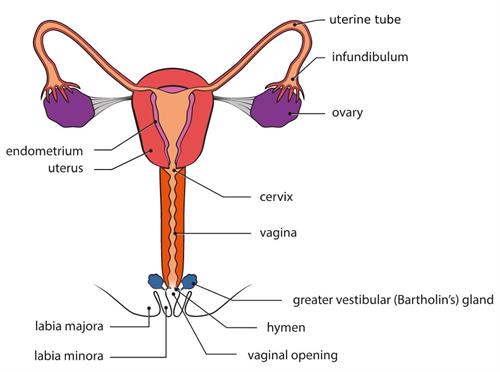
PUMPA - SMART LEARNING
எங்கள் ஆசிரியர்களுடன் 1-ஆன்-1 ஆலோசனை நேரத்தைப் பெறுங்கள். டாப்பர் ஆவதற்கு நாங்கள் பயிற்சி அளிப்போம்
Book Free DemoThe female reproductive organ contains a pair of ovaries, fallopian tubes or the oviducts, uterus and the vagina. The ovaries are the primary sex organs of females.

Female reproductive system
Ovaries:
In females, a pair of almond-shaped ovaries are found near the kidneys in the lower part of the abdominal cavity. Female gonads that contain female gametes (eggs or ova) and secrete female sex hormones are the ovaries (Oestrogen and Progesterone). A mature ovary produces multiple ova in various stages of development.
Important!
The largest human cell is the ovum. The formation of ova is referred to as oogenesis.
Fallopian tubes:
They are also known as oviducts. There are two tubes that come from the uterus, one on each side. The end of the fallopian tube is funnel-shaped, with fimbriae (finger-like projections) near the ovary. The ovum released from the ovary is picked up by the fimbriae and forced into the fallopian tube.
Uterus:
The uterus is a muscular, hollow structure found in the pelvic cavity. It is pear-shaped and is found in between the bladder and the rectum. It is place where the foetus develops.
Vagina:
The uterus narrows down into a tube known as the vagina. It is the structure that connects the cervix and the external genitalia. It receives sperm and serves as a birth canal during the birth of a child (parturition).
Ova are much larger than the sperm and is about \(0.15\)mm in diameter. An egg has a thin layer called the jelly coat that allows only one sperm to enter into it during fertilization. In humans, a matured egg is released into the fallopian tubes by one of the ovaries every month, called ovulation.
Important!
The sperm and the egg have nuclei that contain chromosomes that carry genes which carry genes and transmit the characteristic of the parent to the offspring.
Reference:
https://upload.wikimedia.org/wikipedia/commons/c/ca/Female_genital_system_-_Front_view_1.svg